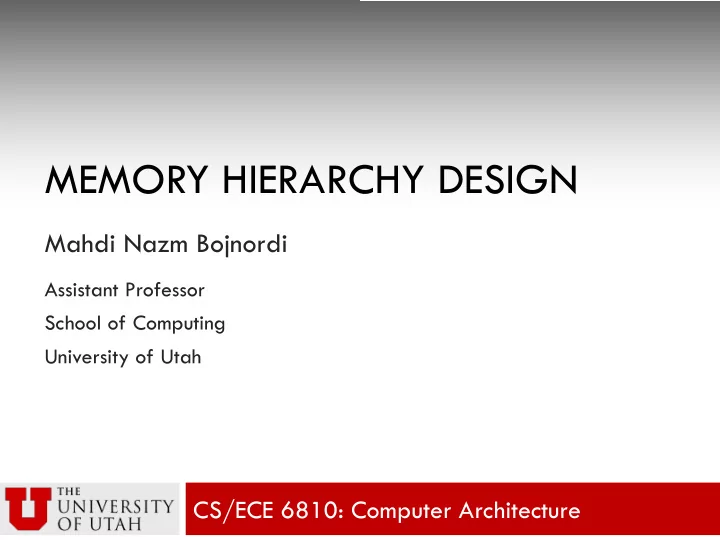

MEMORY HIERARCHY DESIGN Mahdi Nazm Bojnordi Assistant Professor School of Computing University of Utah CS/ECE 6810: Computer Architecture
Overview ¨ Basics ¤ Why use a memory hierarchy ¤ Memory technologies ¤ Principle of locality ¨ Caches ¤ Concepts: block, index, tag, address, cache policies ¤ Performance metric (AMAT) and optimization techniques
Memory Hierarchy “Ideally one would desire an indefinitely large memory capacity such that any particular [...] word would be immediately available [...] We are [...] forced to recognize the possibility of constructing a hierarchy of memories, each of which has greater capacity than the preceding but which is less quickly accessible.” -- Burks, Goldstine, and von Neumann, 1946 Core Level 1 Greater capacity Level 2 Less quickly accessible Level 3
The Memory Wall ¨ Processor-memory performance gap increased over 50% per year ¤ Processor performance historically improved ~60% per year ¤ Main memory access time improves ~5% per year
Modern Memory Hierarchy ¨ Trade-off among memory speed, capacity, and cost small, fast, expensive Register Cache Memory big, slow, inexpensive SSD Disk
Memory Technology ¨ Random access memory (RAM) technology ¤ access time same for all locations (not so true anymore) ¤ Static RAM (SRAM) n typically used for caches n 6T/bit; fast but – low density, high power, expensive ¤ Dynamic RAM (DRAM) n typically used for main memory n 1T/bit; inexpensive, high density, low power – but slow
RAM Cells ¨ 6T SRAM cell bitline bitline ¤ internal feedback wordline maintains data while power on ¨ 1T-1C DRAM cell bitline ¤ needs refresh regularly to wordline preserve data
Cache Hierarchy ¨ Example three-level cache organization L1 Core L1 L2 32 KB L3 1 cycle Application 256 KB 4 MB inst. data 10 cycles 30 cycles 1. Where to put the application? 2. Who decides? Off-chip a. software (scratchpad) Memory 8 GB b. hardware (caches) ~300 cycles
Principle of Locality ¨ Memory references exhibit localized accesses ¨ Types of locality ¤ spatial : probability of access to A + d at time t + e highest when d → 0 ¤ temporal : probability of accessing A + e at time t + d highest when d → 0 for (i=0; i<1000; ++i) { sum = sum + a[i]; } A t temporal spatial spatial temporal Key idea: store local data in fast cache levels
Cache Terminology ¨ Block (cache line): unit of data access ¨ Hit: accessed data found at current level ¤ hit rate: fraction of accesses that finds the data ¤ hit time: time to access data on a hit ¨ Miss: accessed data NOT found at current level ¤ miss rate: 1 – hit rate ¤ miss penalty: time to get block from lower level hit time << miss penalty
Cache Performance ¨ Average Memory Access Time (AMAT) AMAT = r h t h +r m ( t h +t p ) Outcome Rate Access Time r h t h Hit r h = 1 – r m Miss r m t h + t p Request AMAT = t h + r m t p t h cache Hit problem: hit rate is 90%; hit time is 2 cycles; and accessing the lower level takes 200 cycles; Miss find the average memory access time? AMAT = 2 + 0.1x200 = 22 cycles t p
Example Problem ¨ Assume that the miss rate for instructions is 5%; the miss rate for data is 8%; the data references per instruction is 40%; and the miss penalty is 20 cycles; find performance relative to perfect cache with no misses ¤ misses/instruction = 0.05 + 0.08 x 0.4 = 0.082 ¤ Assuming hit time =1 n AMAT = 1 + 0.082x20 = 2.64 n Relative performance = 1/2.64
Recommend
More recommend